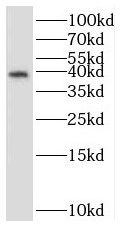Products
STRAP antibody
Category:
Research Area:
- SPECIFICATIONS
- Product Name
- STRAP antibody
- Catalogue No.
- FNab08351
- Size
- 100μg
- Form
- liquid
- Purification
- Immunogen affinity purified
- Purity
- ≥95% as determined by SDS-PAGE
- Clonality
- polyclonal
- Isotype
- IgG
- Storage
- PBS with 0.02% sodium azide and 50% glycerol pH 7.3, -20℃ for 12 months(Avoid repeated freeze / thaw cycles.)
Immunogen
- Immunogen
- serine/threonine kinase receptor associated protein
- Alternative Names
- MAWD antibody, UNRIP antibody
- UniProt ID
- Q9Y3F4
- Observed MW
- 39 kDa
Application
- Tested Applications
- ELISA, WB, IHC, IP
- Recommended dilution
- WB: 1:500-1:2000; IP: 1:200-1:1000; IHC: 1:20-1:200
Validated Images
 mouse brain tissue were subjected to SDS PAGE followed by western blot with FNab08351(STRAP antibody) at dilution of 1:2000
mouse brain tissue were subjected to SDS PAGE followed by western blot with FNab08351(STRAP antibody) at dilution of 1:2000
 IP Result of anti-STRAP (IP:FNab08351, 4ug; Detection:FNab08351 1:2000) with HeLa cells lysate 2000ug.
IP Result of anti-STRAP (IP:FNab08351, 4ug; Detection:FNab08351 1:2000) with HeLa cells lysate 2000ug.
 Immunohistochemistry of paraffin-embedded human ovary using FNab08351(STRAP antibody) at dilution of 1:100
Immunohistochemistry of paraffin-embedded human ovary using FNab08351(STRAP antibody) at dilution of 1:100
- Background
- The SMN complex plays a catalyst role in the assembly of small nuclear ribonucleoproteins(snRNPs), the building blocks of the spliceosome. Thereby, plays an important role in the splicing of cellular pre-mRNAs. Most spliceosomal snRNPs contain a common set of Sm proteins SNRPB, SNRPD1, SNRPD2, SNRPD3, SNRPE, SNRPF and SNRPG that assemble in a heptameric protein ring on the Sm site of the small nuclear RNA to form the core snRNP. In the cytosol, the Sm proteins SNRPD1, SNRPD2, SNRPE, SNRPF and SNRPG are trapped in an inactive 6S pICln-Sm complex by the chaperone CLNS1A that controls the assembly of the core snRNP. Dissociation by the SMN complex of CLNS1A from the trapped Sm proteins and their transfer to an SMN-Sm complex triggers the assembly of core snRNPs and their transport to the nucleus. STRAP plays a role in the cellular distribution of the SMN complex. Negatively regulates TGF-beta signaling but positively regulates the PDPK1 kinase activity by enhancing its autophosphorylation and by significantly reducing the association of PDPK1 with 14-3-3 protein.



